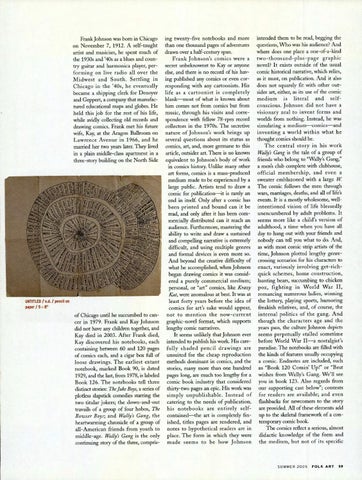Frank Johnson was born in Chicago on November 7, 1912. A self-taught artist and musician, he spent much of the 1930s and '40s as a blues and country guitar and harmonica player, performing on live radio all over the Midwest and South. Settling in Chicago in the '40s, he eventually became a shipping clerk for Denoyer and Geppert,a company that manufactured educational maps and globes. He held this job for the rest of his life, while avidly collecting old records and drawing comics. Frank met his future wife, Kay, at the Aragon Ballroom on Lawrence Avenue in 1966, and he married her two years later. They lived in a plain middle-class apartment in a three-story building on the North Side
UNTITLED / n.d. / pencil on paper / 5 8"
of Chicago until he succumbed to cancer in 1979. Frank and Kay Johnson did not have any children together, and Kay died in 2003. After Frank died, Kay discovered his notebooks, each containing between 60 and 120 pages of comics each, and a cigar box full of loose drawings. The earliest extant notebook, marked Book 90, is dated 1929,and the last,from 1978,is labeled Book 126. The notebooks tell three distinct stories: TheJuke Boys, a series of plotless slapstick comedies starring the two titular jokers; the down-and-out travails of a group of four hobos, The Bowser Boys; and Wally's Gang, the heartwarming chronicle of a group of all-American friends from youth to middle-age. Wally's Gang is the only continuing story of the three, compris-
ing twenty-five notebooks and more than one thousand pages of adventures drawn over a half-century span. Frank Johnson's comics were a secret unbeknownst to Kay or anyone else, and there is no record of his having published any comics or even corresponding with any cartoonists. His life as a cartoonist is completely blank—most of what is known about him comes not from comics but from music, through his visits and correspondence with fellow 78-rpm record collectors in the 1970s. The secretive nature of Johnson's work brings up several questions about its status as comics, art, and, more germane to this article, outsider art. There is no known equivalent to Johnson's body of work in comics history. Unlike many other art forms, comics is a mass-produced medium made to be experienced by a large public. Artists tend to draw a comic for publication—it is rarely an end in itself. Only after a comic has been printed and bound can it be read, and only after it has been commercially distributed can it reach an audience. Furthermore, mastering the ability to write and draw a sustained and compelling narrative is extremely difficult, and using multiple genres and formal devices is even more so. And beyond the creative difficulty of what he accomplished, when Johnson began drawing comics it was considered a purely commercial medium; personal, or "art" comics, like Krazy Kat,were anomalous at best. It was at least forty years before the idea of comics for art's sake would appear, not to mention the now-current graphic-novel format, which supports lengthy comic narratives. It seems unlikely that Johnson ever intended to publish his work. His carefully shaded pencil drawings are unsuited for the cheap reproduction methods dominant in comics, and the stories, many more than one hundred pages long, are much too lengthy for a comic book industry that considered thirty-two pages an epic. His work was simply unpublishable. Instead of catering to the needs of publication, his notebooks are entirely selfcontained—the art is completely finished, titles pages are rendered, and notes to hypothetical readers are in place. The form in which they were made seems to be how Johnson
intended them to be read, begging the questions,Who was his audience? And where does one place a one-of-a-kind two-thousand-plus-page graphic novel? It exists outside of the usual comic historical narrative, which relies, as it must, on publication. And it also does not squarely fit with other outsider art, either, as its use of the comic medium is literal and selfconscious. Johnson did not have a visionary zeal to invent forms and worlds from nothing. Instead, he was simulating a medium—comics—and inventing a world within what he thought comics should be. The central story in his work Wally's Gang is the tale of a group of friends who belong to "Wally's Gang," a men's club complete with clubhouse, official membership, and even a sweater emblazoned with a large W The comic follows the men through wars, marriages, deaths, and all of life's events. It is a mostly wholesome, wellintentioned vision of life blessedly unencumbered by adult problems. It seems more like a child's version of adulthood, a time when you have all day to hang out with your friends and nobody can tell you what to do. And, as with most comic strip artists of the time, Johnson plotted lengthy genrecrossing scenarios for his characters to enact, variously involving get-richquick schemes, home construction, hunting bears, succumbing to chicken pox, fighting in World War II, romancing numerous ladies, winning the lottery, playing sports, humoring freakish relatives, and, of course, the internal politics of the gang. And though the characters age and the years pass, the culture Johnson depicts seems perpetually stalled sometime before World War II—a nostalgist's paradise.The notebooks are filled with the kinds offeatures usually occupying a comic. Endnotes are included, such as 'Book 120 Comin' Up!" or "Best wishes from Wally's Gang. We'll see you in book 123. Also regards from our supporting cast below"; contests for readers are available; and even flashbacks for newcomers to the story are provided. All ofthese elements add up to the skeletal framework of a contemporary comic book. The comics reflect a serious, almost didactic knowledge of the form and the medium, but not of its specific
SUMMER 2005
FOLK ART
59
